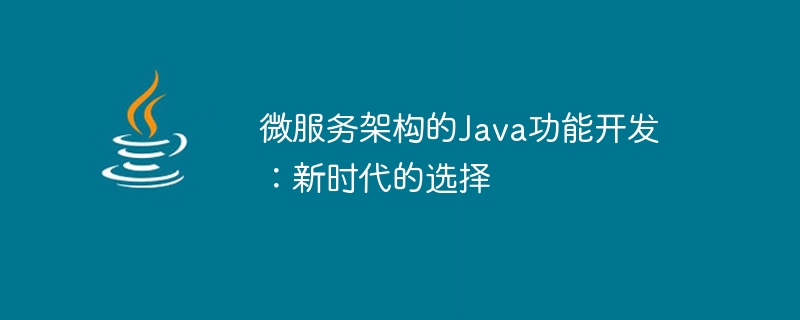Home >Java >javaTutorial >Java function development for microservice architecture: a choice in the new era
Java function development for microservice architecture: a choice in the new era
- WBOYWBOYWBOYWBOYWBOYWBOYWBOYWBOYWBOYWBOYWBOYWBOYWBOriginal
- 2023-09-18 10:45:501369browse

Java function development of microservice architecture: the choice in the new era
With the continuous development of Internet technology, the traditional single application architecture can no longer meet the needs of rapid iteration and High concurrency requirements. In order to better cope with these challenges, microservice architecture emerged as the times require. As a new architectural idea, microservice architecture achieves better scalability and maintainability by splitting a large application into multiple small services.
As a programming language widely used in enterprise-level development, Java has naturally become one of the first choices for microservice architecture. The Java language has a wealth of open source frameworks and libraries that can effectively support the development and deployment of microservices. This article will introduce how to use Java to develop functions under a microservice architecture and provide some specific code examples.
- Service splitting and design
In the microservice architecture, you first need to split a large application into multiple small services. Each small service only focuses on a specific business function, which makes the service more focused and independent. The principle of splitting can be based on business areas, functional modules or technology stacks.
Designing a good microservice architecture requires considering the following aspects:
- High cohesion and low coupling: Each service should have clear responsibilities and boundaries to avoid over-reliance on others Serve.
- Independent deployment: Each service can be deployed and expanded independently without affecting other services.
- Easy to integrate: Each service needs to communicate through a simple interface to maintain good integration capabilities.
- Build services using Spring Boot
Spring Boot is an open source project based on the Spring framework, which simplifies the development and deployment process of Java applications. Through Spring Boot, developers can quickly create independent, production-level Spring applications.
The following is an example of using Spring Boot to create a RESTful API:
@RestController
@RequestMapping("/api")
public class UserController {
@Autowired
private UserService userService;
@GetMapping("/users/{id}")
public User getUser(@PathVariable("id") long id) {
return userService.getUserById(id);
}
@PostMapping("/users")
public User addUser(@RequestBody User user) {
return userService.addUser(user);
}
@DeleteMapping("/users/{id}")
public void deleteUser(@PathVariable("id") long id) {
userService.deleteUser(id);
}
}In the above code, by using Spring Boot’s annotations and autowiring features, we can quickly create an API to handle user-related requests RESTful API.
- Using Spring Cloud for service governance
In the microservice architecture, service discovery, load balancing and fault tolerance are very important. Spring Cloud is an open source project based on Spring Boot, providing a complete microservice solution.
Through Spring Cloud, developers can easily implement functions such as service registration and discovery, load balancing, circuit breakers, and configuration management. The following is an example of using Spring Cloud Netflix to implement service discovery and load balancing:
@RestController
@RequestMapping("/api")
public class UserController {
@Autowired
private RestTemplate restTemplate;
@GetMapping("/users/{id}")
public User getUser(@PathVariable("id") long id) {
return restTemplate.getForObject("http://user-service/user/" + id, User.class);
}
// ...
}In the above code, by injecting the RestTemplate object, we can easily call the API of other services, here "user-service" is a service name registered in Eureka.
- Using Docker for containerized deployment
In the microservice architecture, the deployment and expansion of services are very frequent, while the traditional virtual machine deployment method often requires more time. long time. Docker is an open source containerization engine that can realize fast and lightweight virtualization applications.
Through Docker, we can package each service into an independent container and use container orchestration tools such as Kubernetes for management. Here is an example of using Docker to build and run a Spring Boot application:
FROM openjdk:8-jdk-alpine COPY target/myapp.jar /app/ CMD ["java", "-jar", "/app/myapp.jar"]
By placing the above Dockerfile in the root directory of the project, we can use Docker commands to build the image and run the application.
Summary:
The Java function development of microservice architecture gives us greater freedom and flexibility, allowing us to better respond to complex business needs. By using open source tools such as Spring Boot, Spring Cloud, and Docker, we can quickly build and deploy highly scalable microservice applications.
However, the microservice architecture also brings some challenges, such as the complexity of service invocation, service monitoring and tuning, etc. Therefore, in actual development, we should choose an appropriate architectural solution based on specific needs and scenarios.
The above is the detailed content of Java function development for microservice architecture: a choice in the new era. For more information, please follow other related articles on the PHP Chinese website!
Related articles
See more- How to monitor and optimize services in microservice architecture?
- How to deal with dependencies between services in microservice architecture?
- How to use PHP for basic microservice architecture design
- How to perform log analysis and alarm for Java function development
- How microservices architecture leads the new wave of Java feature development

